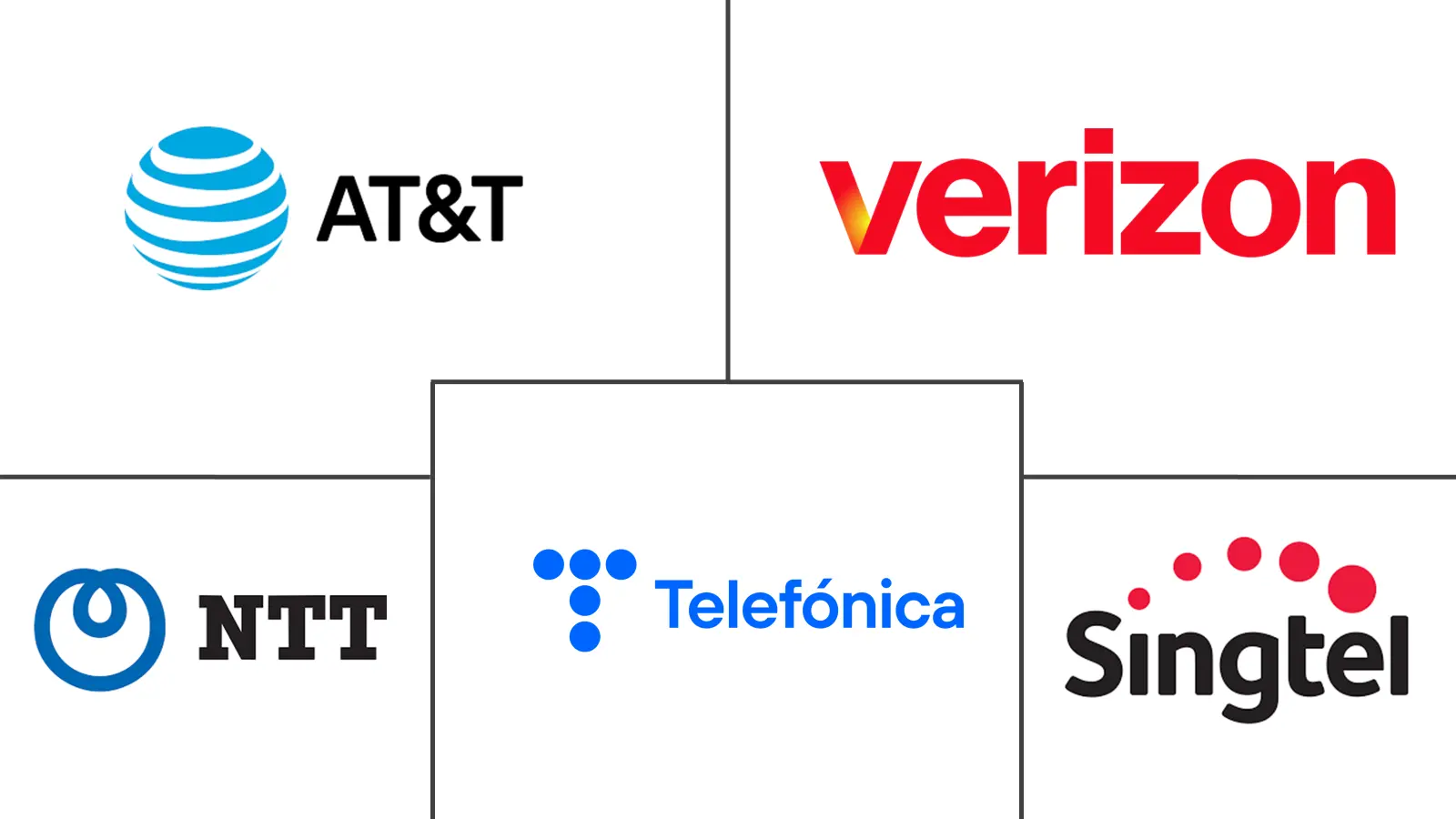Broadband Services Market Size and Share
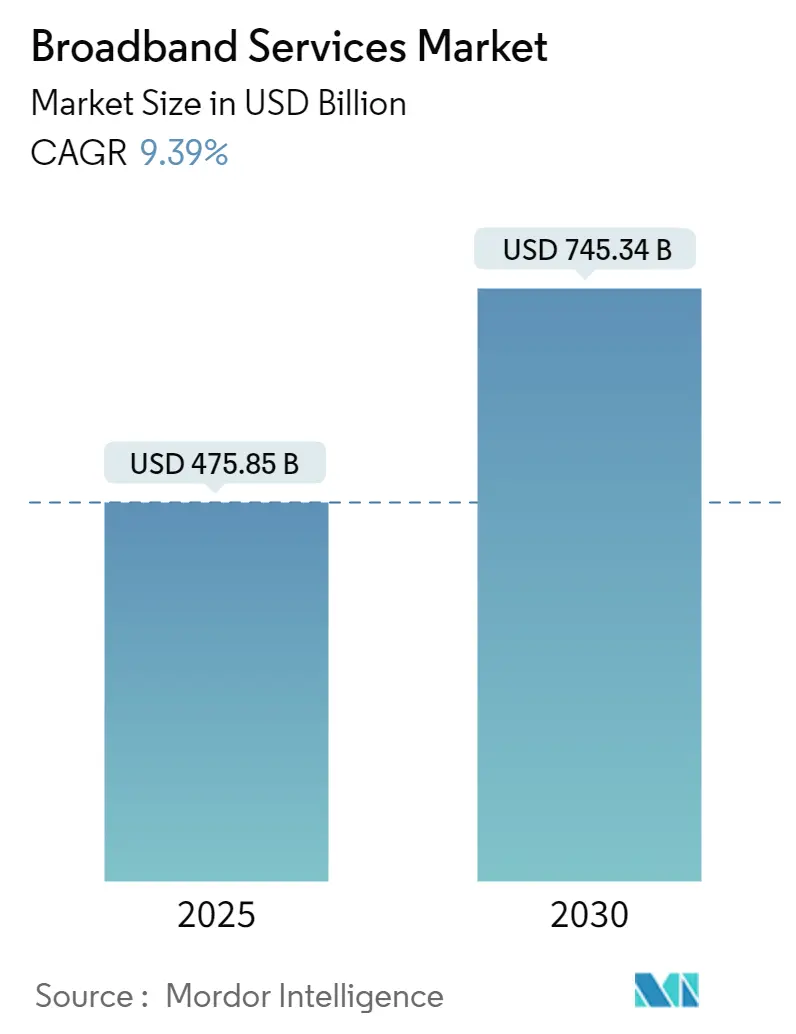
Broadband Services Market Analysis by Mordor Intelligence
The Broadband Services Market size is estimated at USD 475.85 billion in 2025, and is expected to reach USD 745.34 billion by 2030, at a CAGR of 9.39% during the forecast period (2025-2030).
- Recent statistics from the International Telecommunication Union (ITU) reveal a global surge in internet connectivity, with over 5.4 billion users. This expanding digital populace is increasingly driving the demand for broadband services as individuals seek dependable internet access for work, education, and entertainment.
- The COVID-19 pandemic hastened the shift from analog to digital platforms, underscoring the critical role of internet access in achieving socioeconomic inclusion. With businesses, educational institutions, and services transitioning online, the appetite for robust broadband connectivity has grown.
- Technological advancements, including the deployment of fiber optic networks and enhancements in mobile broadband (3G, 4G, and LTE), have bolstered the speed and reliability of internet services. Such improvements not only attract consumers and businesses but also propel further adoption.
- Moreover, government initiatives, like smart city programs leveraging fibre optic networks, aim to streamline IoT infrastructure. These networks empower utilities, from data centres to electricity and wastewater management, ensuring their security and communication. The United Nations projects that by 2050, 68% of the global population will reside in urban areas, potentially spurring a rise in global smart city projects.
- Yet, despite the surging demand for broadband services, growth faces hurdles. In numerous regions, especially rural and underserved locales, inadequate infrastructure significantly hampers broadband expansion. Establishing essential infrastructure, like fibre optic cables and cellular towers, is often a costly and time-intensive endeavor, restricting service reach.
- Recent shifts in global macroeconomic dynamics are poised to impact the broadband market's trajectory. Take, for example, the escalating Russia-Ukraine conflict and surging inflation, both of which cast long shadows on the development of broadband services. The war has disrupted global supply chains, particularly affecting the availability of crucial telecommunications equipment. Numerous nations depend on components sourced from the conflict zone, and with sanctions on Russia, logistics and procurement have become even more intricate. Such material shortages can stall the rollout and enhancement of broadband infrastructure, curtailing global service expansion and upgrades.
Global Broadband Services Market Trends and Insights
Fixed-Line Broadband Connections are Expected to Hold a Significant Market Share
- As consumers increasingly turn to the internet for activities like streaming, gaming, and remote work, the demand for faster, more reliable connections intensifies. This surge in demand compels service providers to bolster their fixed-line offerings, aligning with consumer expectations for enhanced speed and performance.
- With the rise of online transactions and virtual meetings, companies are turning to 5G and optic fiber cables to maintain their competitive edge. These cables offer cost-effective and convenient solutions for diverse industrial applications, including lighting, data transmission, surgeries, and mechanical inspections. The global shift towards work-from-home and hybrid models further amplifies the demand for FTTH, propelling the market.
- Furthermore, the demand for single-mode fiber to the home (FTTH) is surging, especially in FTTH broadband and 5G deployments. Recent moves by industry leaders to transition their core architecture to FTTH are set to accelerate full-fiber rollouts, particularly in the UK, Germany, and Italy. According to a report from ftthcouncil.eu, in 2022, EU39 surpassed 111 million FTTH subscriptions, with 62% originating from EU27+UK. Projections indicate Europe will exceed 190 million FTTH subscriptions by 2027, with EU27+UK contributing 65%, translating to over 123 million subscriptions.
- Global government initiatives to bolster 5G deployment are fueling market expansion. For example, the European Commission, recognizing the pivotal role of 5G, formed a public-private partnership to advance its technology. Consequently, they allocated over GBP 700 million through the Horizon 2020 Program to bolster 5G deployment across Europe.
- According to the International Telecommunication Union, wired broadband subscriptions surged to nearly 1.5 billion globally in 2023, up from 918 million in 2016. This growth trajectory is poised to bolster the demand for broadband services in the coming years.
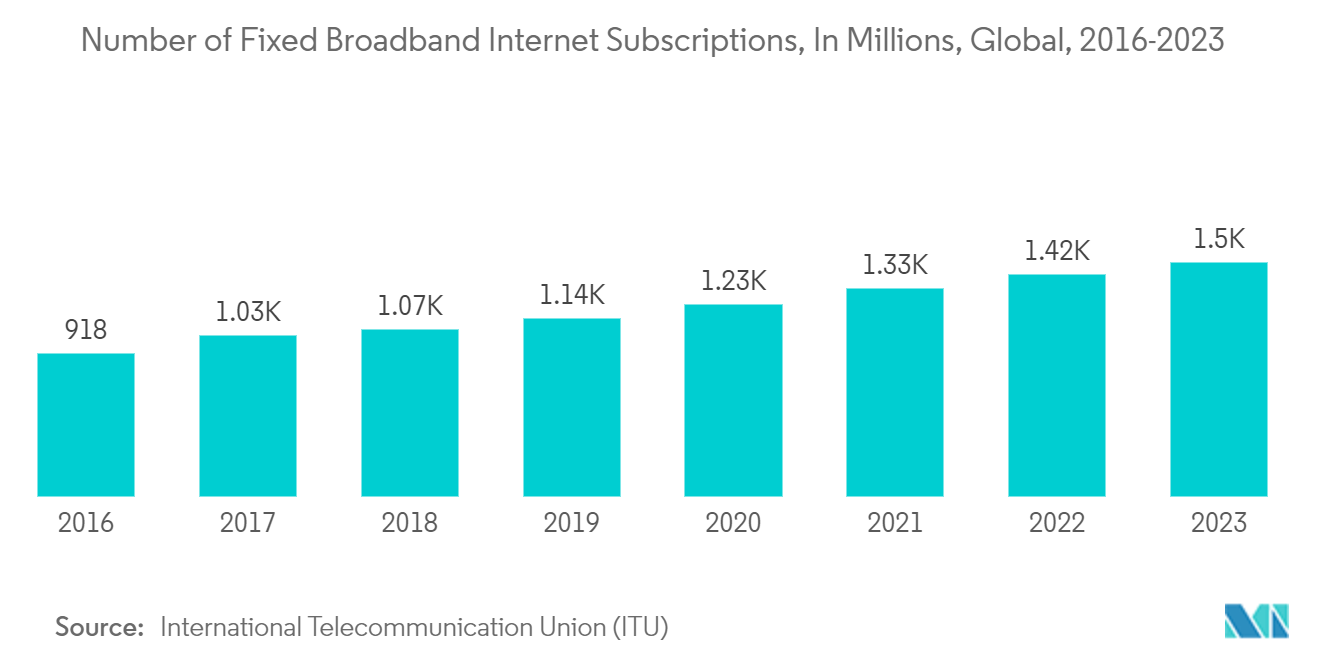
Asia-Pacific is Expected to Register a Significant Growth
- Technological advancements, economic factors, and government initiatives are driving significant growth in broadband services across the Asia-Pacific region. A major catalyst for this growth has been the deployment of fiber optic technology. According to GSMA, after North America, Europe, and Central Asia, East Asia & Pacific ranks fourth in mobile internet adoption, with 71% of its population actively using it.
- The region boasts some of the world's fastest-growing economies. As these economies develop and urbanize, there's an escalating demand for enhanced infrastructure, notably in broadband services. With urban expansion and a rising population, the appetite for high-speed internet intensifies, leading to increased investments in broadband infrastructure.
- China, under its 14th Five-Year Plan (FYP) for 2021-2025, is placing a strong emphasis on developing new infrastructure. This comprehensive plan, influencing China's direction until 2025, encompasses a wide range of sectors, from gigabit fiber optics to space-based infrastructure. As a result, these initiatives are set to significantly boost the growth of the studied market in China.
- Key tasks under this initiative include upgrading gigabit fiber-optic networks, rolling out 5G networks on a large scale, enhancing 5G adoption, and laying the foundation for 6G technology.
- In 2023, SoftBank, a leading Japanese telecommunications operator, announced the successful nationwide rollout of an all-optical network utilizing a disaggregated architecture. This initiative aims to create a carbon-neutral network, addressing the surging demand for data communication.
- India, propelled by initiatives like "Digital India," is witnessing a rapid surge in its internet-connected population. Data from the Telecom Regulatory Authority of India (TRAI) indicates that as of February 2024, India boasted 39.4 million wired broadband subscribers. Given these trends and developments, the studied market is poised for substantial growth in the coming years.
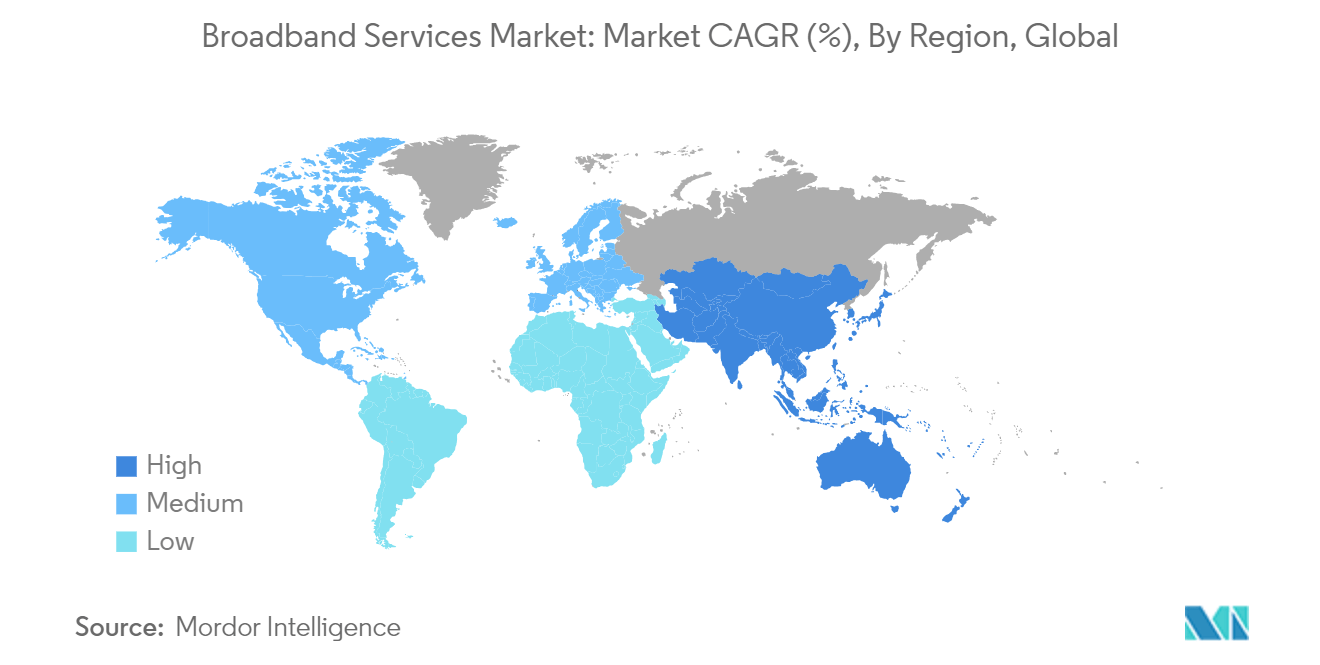
Competitive Landscape
The broadband services market exhibits a high degree of fragmentation, featuring a mix of global conglomerates and specialized players across its diverse segments. While a handful of large multinational corporations dominate certain lucrative segments, a multitude of regional and niche players intensify the competition, underscoring the market's diversity. This fragmentation stems from the myriad applications of broadband services, creating an environment where both large and small entities can coexist and flourish.
Prominent players in the broadband services arena encompass AT&T, Verizon, Comcast, and Telefonica, to name a few. These industry giants boast robust brand recognition and a vast global footprint, allowing them to capture a substantial market share. Their competitive advantages include a commitment to innovation, a diverse product portfolio, and a well-established distribution network. To further bolster their market position, these leaders frequently pursue strategic acquisitions and forge partnerships.
Success in the broadband services market hinges on a company's commitment to innovation. Beyond this, broadening service offerings and elevating customer support are vital for nurturing long-term relationships and ensuring repeat business. Firms that channel investments into emerging markets and tailor their products to meet regional demands stand to gain a significant edge in this fragmented landscape.
Broadband Services Industry Leaders
-
AT&T
-
Verizon
-
NTT Group
-
Telefonica
-
Singtel
- *Disclaimer: Major Players sorted in no particular order
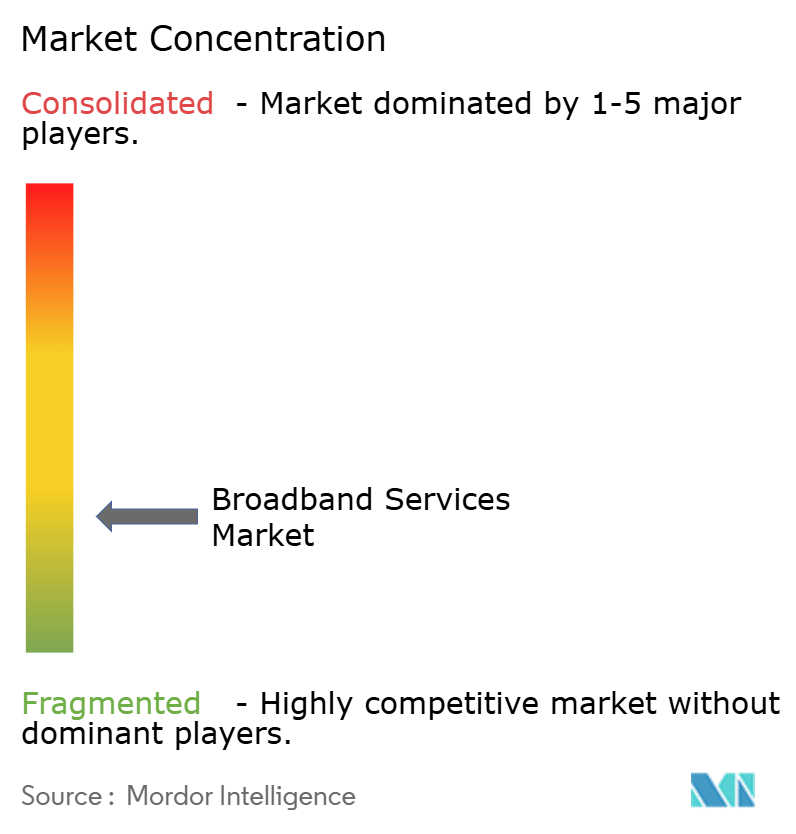
Recent Industry Developments
- September 2024: HyperFiber, a leading fibre internet provider, has officially launched its services in Firestone, Colorado. With this installation, over 5,000 homes in the region can now tap into HyperFiber's fully fibre-optic network, reaping the benefits of high-speed, fibre-to-the-home internet.
- September 2024: Spectrum has rolled out high-speed internet services to more than 1,700 sites in Knox County. As part of a broader commitment, the company is undertaking a multi-year, USD 9 billion construction initiative aimed at connecting approximately 1.75 million new homes and small businesses across the nation. Specifically in Knox County, Spectrum has poured in an investment of about USD 16.4 million, extending fibre optic cable services to nearly 3,000 locations.
- August 2024: CityFibre, United Kingdom'sKingdom's independent full-fibre platform, signed a long-term partnership with Sky that will see the broadband provider offer gigabit services to customers on CityFibre'sCityFibre's nationwide full-fibre network. Sky Broadband currently has a customer base of 6.7 million across the UK and Ireland, with services in the UK delivered by BT's broadband provision division Openreach, making it the second-largest residential provider in the UK after BT.
Global Broadband Services Market Report Scope
Broadband services provide high-speed, always-on internet access, surpassing the speeds of traditional dial-up connections. With these services, users can seamlessly engage in activities like streaming videos, online gaming, video conferencing, and web browsing, all without noticeable delays or interruptions.
For market estimation, the study monitors the revenue generated from broadband services by various global players. Additionally, the future market outlook is adjusted based on key growth drivers and overarching macroeconomic trends.
The broadband services market is segmented by connection type (fixed-line [digital subscriber line, cable and fibre optic], wireless [mobile broadband and fixed wireless broadband], and satellite), application (residential, commercial, others), and geography (North America, Europe, Asia-Pacific, Latin America, Middle East and Africa). The market sizes and forecasts are provided in terms of value (USD) for all the above segments.
| Fixed-Line | Digital Subscriber Line |
| Cable | |
| Fiber Optic | |
| Wireless | Mobile Broadband |
| Fixed Wireless Broadband | |
| Satellite |
| Residential |
| Commercial |
| Others |
| North America |
| Europe |
| Asia |
| Australia and New Zealand |
| Latin America |
| Middle East and Africa |
| By Connection Type | Fixed-Line | Digital Subscriber Line |
| Cable | ||
| Fiber Optic | ||
| Wireless | Mobile Broadband | |
| Fixed Wireless Broadband | ||
| Satellite | ||
| By Application | Residential | |
| Commercial | ||
| Others | ||
| By Geography*** | North America | |
| Europe | ||
| Asia | ||
| Australia and New Zealand | ||
| Latin America | ||
| Middle East and Africa | ||
Key Questions Answered in the Report
How big is the Broadband Services Market?
The Broadband Services Market size is expected to reach USD 475.85 billion in 2025 and grow at a CAGR of 9.39% to reach USD 745.34 billion by 2030.
What is the current Broadband Services Market size?
In 2025, the Broadband Services Market size is expected to reach USD 475.85 billion.
Who are the key players in Broadband Services Market?
AT&T, Verizon, NTT Group, Telefonica and Singtel are the major companies operating in the Broadband Services Market.
Which is the fastest growing region in Broadband Services Market?
Asia Pacific is estimated to grow at the highest CAGR over the forecast period (2025-2030).
Which region has the biggest share in Broadband Services Market?
In 2025, the North America accounts for the largest market share in Broadband Services Market.
What years does this Broadband Services Market cover, and what was the market size in 2024?
In 2024, the Broadband Services Market size was estimated at USD 431.17 billion. The report covers the Broadband Services Market historical market size for years: 2019, 2020, 2021, 2022, 2023 and 2024. The report also forecasts the Broadband Services Market size for years: 2025, 2026, 2027, 2028, 2029 and 2030.
Page last updated on:
Broadband Services Market Report
Statistics for the 2025 Broadband Services market share, size and revenue growth rate, created by Mordor Intelligence™ Industry Reports. Broadband Services analysis includes a market forecast outlook for 2025 to 2030 and historical overview. Get a sample of this industry analysis as a free report PDF download.
